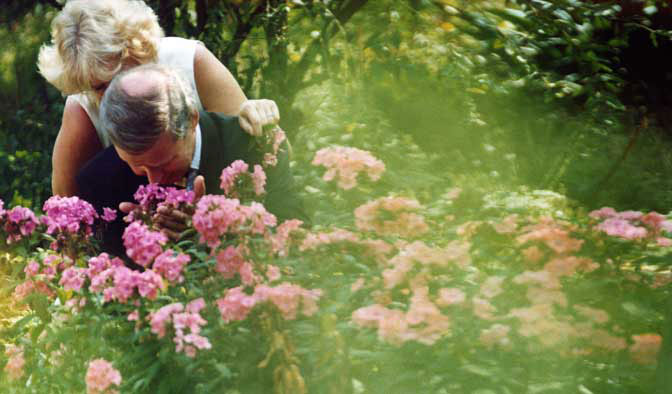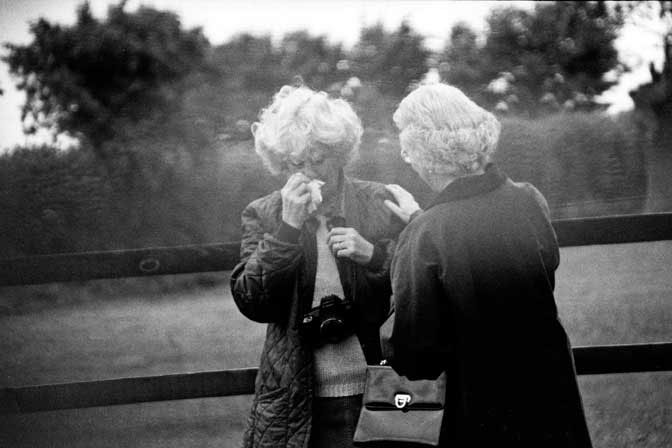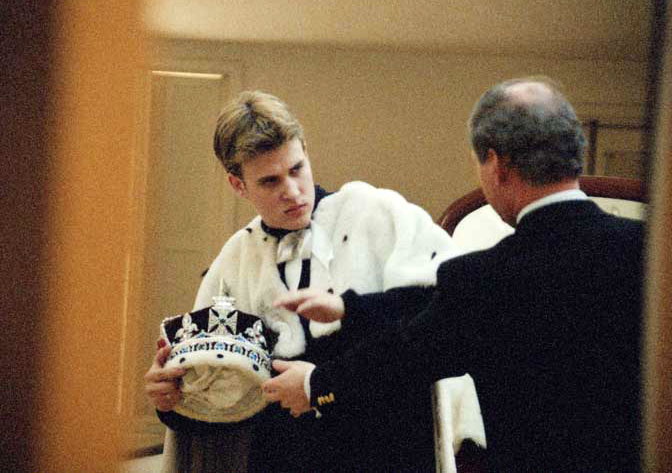
When it came to venues for the pantomime known as the royal (and possibly even legal) wedding between the love rat Prince Charles and the adulterous Mrs. Parker Bowles, you couldn’t have found any place better than Guildhall at Windsor. It is the English equivalent of the Little Church in the Dell in Las Vegas, a sham-grand location for marriage tearaways: the young, the desperate, and the divorced in search of a second chance. For one thing, Guildhall has never been a guild’s hall—despite the pretentious name, it has never been anything more impressive than Windsor’s seat of municipal government. It is overshadowed by, and a mere 184 paces from, the portcullis of Windsor Castle, the royal family’s favourite digs and top money-spinner, being a tourist trap drawing more than one million visitors a year. But most of these visitors will pass unwittingly by Guildhall. Very much like the bride, the building is forgettable despite its venerable age and pedigree, having been designed by Sir Christopher Wren in a classical revival style far more ostentatious than its modest dimensions can accommodate.
It had originally been Charles’s wish to marry in the regal surroundings of the castle, with a dedication ceremony to follow in St. George’s Chapel, amid the hushed reverence of carved oak, heraldic flags, and carved stone sepulchres holding the remains of his crowned ancestors. This proved problematic; if the royals were to marry in the chapel, an obscure English law would take effect, allowing commoners to marry there as well. So the proceedings were moved to Guildhall. It was a more appropriate choice. At Guildhall, the atmosphere is one of overstuffed formality and faded glory, in keeping with the falling fortunes of the royal family. On the inside, it is all burnished oak, stiff-backed chairs, and framed portraits of old royals, but on the outside, it has fallen to municipal neglect.
To one side of the entrance, a notice board sports regulations governing trash collection and ads for upcoming music recitals. The covered entrance is supported by Tuscan columns, now blackened with motor soot from the stream of cars crawling along the busy high street. Guildhall is surrounded on all sides by a clashing riot of Chinese, Thai, and fast-food restaurants, offering the hordes food on the cheap—and a possible source of caterers for the Queen, who agreed to foot the bill for the wedding reception. Most arresting of all is the fact that the Guildhall entrance is flanked by steps leading down to Windsor’s busiest public conveniences. Some feared that the “Ladies” and “Gentlemen” rooms, with their astringent scent of the pissoir, would provide a pungent counterpoint to the happy couple (or at least, as happy as Charles ever gets) when they emerged, married, on April 8.
From the beginning, the wedding plans were a comedy of errors—if the word “comedy” can be applied to something so very sad. First, the change in venue, next the legal challenges from the Church of England to the validity of the wedding, then the Queen’s decision not to attend, followed by polls showing most Britons would prefer to see the succession skip a generation and have Prince William as their next king, passing over Charles altogether. In this respect, the public was in fact reflecting the Palace in its thinking—this so-called “doomsday scenario” was presented to the Queen by her courtiers in 1998, and the monarch was reportedly “not at all averse to the idea.”
Despite this wishful thinking, it is altogether unlikely. The constitutional precedent for abdication is Edward VIII, whose wish to marry the divorcée Wallis Simpson left both Parliament and the country divided. Today, Charles’s wish to marry the divorced Mrs. Bowles has the enthusiastic support of the Blair government, which hopes to benefit from a feel-good wedding bounce at the outset of its campaign for a May 5 general election. Charles also has the grudging support of the Archbishop of Canterbury, who was willing to bless, if not consecrate, the union. As far as the British public is concerned, the general mood of who-cares-let-them-get-on-with-it was summed up in the Daily Star headline: “Boring Old Git Gets to Wed.”

But the wedding has troubling implications for the fifteen Commonwealth countries that retain the British monarch as head of state, no less than for Britain itself. The bells of St. George’s ringing in the royal couple may well be sounding the death knell for the monarchy in its present form. It is not only in Britain that the announcement of the royal marriage has led to a decline in support for Charles as king—and, by extension, for Camilla as queen. “The Commonwealth will not tolerate Camilla in any shape or form,” said one royal courtier, “especially Canada, New Zealand, and Australia.”
Anticipating this, Charles announced that Camilla would not be styled as queen when he ascends to the throne, but instead would become something called “Princess Consort,” a neologism contrived for the occasion with no precedent in 1,000 years of the unbroken line of succession, and no standing in law. Neither would she assume the title of Princess of Wales—a title that has apparently been retired, like a hockey jersey, with the death of Diana, the secular saint of broken hearts and light eaters. Instead, Camilla will be known as the Duchess of Cornwall, a title unfortunately similar to the market brand of Duchy Originals, the product line of high-class biscuits, sausages, and ciders spun from Charles’s organic Highgrove estate.
Both of Camilla’s titles are mere invention born of wishful thinking on Charles’s part, as the Queen recognized—being far wiser in constitutional matters—when she approved the hrh designation for Camilla, a distinction reserved for family members in immediate proximity to the throne. (The Queen similarly stripped the hrh from Diana once her divorce removed the throne from her grasp.)
If Elizabeth believed that Camilla would never be queen, the hrh would not have been bestowed. The simple fact is that there is neither precedent nor protocol in British legal tradition for the wife of a king to be anything other than queen, no matter what fiction Charles tells to his marigolds. There is no provision in Britain, as there is elsewhere in Europe, for morganatic marriages, meaning those between a high-born royal and a lesser-born commoner, whereby the children assume none of the royal perquisites or privileges. (During the 1936 abdication crisis, Edward viii had proposed a morganatic marriage as a compromise position allowing him to marry Wallis Simpson. This was rejected by Prime Minister Stanley Baldwin as unacceptable to either Britain or its dominions. He was left with no option but to abdicate—a path Charles has shown no interest in taking.)
In Britain, the husband of a queen does not automatically become king for the simple reason that he would then outrank his wife—hence, Prince Philip is the Duke of Edinburgh, a title that does not even outrank his two eldest sons. But in Britain the wife of a king always, without exception, becomes his queen. Charles can call Camilla the Duchy Original Princess Pie if he wants to, but there is no escaping the conclusion that with their marriage, Camilla is destined to become queen of the United Kingdom and, by extension, Queen Camilla of Canada.

And therein lies the rub. For, as king and queen, Charles and Camilla will assume more than figurehead roles as heads of state, lend their names to charitable causes, and trot out a ceremonial coach every few years for the national bonding rituals of weddings and funerals. They will also be, under the 1701 Act of Union, the Supreme Governors of the Church of England and the Defenders of the Faith. Charles, whose woolly-headed thinking is all false starts and quixotic intentions, would like this changed to “Defender of Faiths” to reflect the multicultural aspect of modern British society. The response from Britain’s rainbow of Muslims, Sikhs, African Christians, and 4 million Catholics has been deafening in its silence for one reason alone: none of them regard his marriage to Camilla as valid.
Neither, for that matter, does the self-same Church of England, which Charles will one day lead. The Church of England’s synod recently allowed for the remarriage of divorced persons, but only if their adultery was not the cause of marriage breakdown, which neither Charles nor Camilla can honestly plead. Charles was, according to various accounts, sleeping with Camilla as late as two nights before his marriage to Diana and as soon as two weeks after, and Diana publicly cited the affair as a cause of the marriage breakdown. Even receiving a church blessing of their civil marriage, under the strictest letter of canonical law, would require the couple to express penitence three times for all their out-of-wedlock shagging these past twenty years, something they were as likely to do as to support the ban on fox hunting.
All of this may sound like theological hairsplitting, but it goes to the heart of the objections lodged against the wedding and the Queen’s distaste for the proceedings. The British monarch is both spiritual and temporal head of the United Kingdom and Commonwealth, but its temporal powers are now limited to those of moral suasion—and how can the Crown hope to cling to moral authority when it pursues its own pleasure, in violation of the Church’s teaching?
Edward viii is a case in point. And the Queen’s own sister, Princess Margaret, was denied her wish to marry Group Captain Peter Townsend on the grounds that he was divorced. It was a source of lifelong unhappiness for her, but she surrendered—as the Windsors, until now, have always surrendered—to public duty before personal pleasure. It is understandable, then, that the Queen would refer to Camilla in private as “that wicked woman” and complain to Charles that his marriage to her puts “personal gratification ahead of duty.”
Indeed, there is only one precedent in English history for the divorce and remarriage of a monarch, the Tudor King Henry viii, who disowned his first wife Catherine of Aragon in favour of Anne Boleyn. The Lord Chancellor at that time was the English saint, Sir Thomas More, who opposed the remarriage, and lost his head. Nearly 500 years on, the Lord Chancellor today (solicitor-general-cum-speaker of the House of Lords) is Lord Falconer a former roommate of Prime Minister Tony Blair. He reached into the murky waters of European human rights legislation to declare the marriage between Charles and Camilla legal, despite 170 years of English laws forbidding royals to marry outside the Anglican Church. Falconer’s ruling was bad law but good politics, and, unlike More, he managed to keep head and shoulders intact.
The British Crown has long sought to retain relevance through a certain moral and guiding influence over the people. That ambition, it appears, will die with the present Queen. What the marriage of Charles and Camilla represents is the departure from sacrifice, ritual, and tradition, and the embrace of fame for fame’s sake. Elizabeth’s reign was exercised by royal jelly based on mystique and ceremony, as a sort of living incarnation of the British ideal. Charles will reign along with the supermarket sales of Duchy Originals jelly, his authority based on the principles of organic husbandry and low-impact architecture. He has traded the air of mystery for the allure of celebrity, a process that began with the publication of his extended whinge in the Jonathan Dimbleby book The Prince of Wales (my mother never talks to me; I never loved Diana; that brute Philip forced me to marry her) and end with the exchange of vows in Guildhall.
Ironically enough, the turning point in the monarchy’s fortunes, the one figurehead who presaged the passing of ceremony and the advent of celebrity, was Diana. She was the first postmodern royal, the first to realize that the monarchy could no longer hide behind a veil of secrecy. With naive cunning, she manipulated the media and provided it with the requisite storyline, casting herself in the role of principal saint and victim, a helpless pawn in the heartless Windsor grip. At the same time that she was a victim herself, she openly embraced victims. Not for her the aloof patronage of charitable causes: she hugged the aids victim and consoled the limbless casualties of land mines, in the process turning herself into a hagiographic image for the electronic age.
She achieved this in part through what English philosopher Anthony O’Hear calls the newest form of political correctness—“emotional correctness,” whereby the individual has no higher calling than the pursuit of personal happiness. In order to record her heroic struggle, it was necessary for Diana to expose publicly the intimate details of her life. This she did, through a series of private background briefings with tabloid editors, the Andrew Morton books, and the bbc interview in which she confessed to her own and Charles’s infidelities. It was all laid bare: her bulimia, her suicide attempt, her string of disappointing lovers—all were spilled like blue blood on the carpet.
The Queen in particular was mortified: Diana not only won the public relations battles, now she was eroding the shoreline of royal mystique. How long would it be before the “barbarous” philosophy that moved the French revolution would be afoot in Britain, a philosophy in which, as Sir Edward Burke described it, “a king is but a man; a queen is but a woman; a woman is but an animal; and an animal not of the highest order.”
And where does the Diana legacy leave the royal family, seven years after her death? Let us peruse the smoking remains. Shorn of its air of nobility and reduced to the level of pop idols, the royals find they are second-rank in the celebrity stakes. They are devoted to good works, but not as devoted as Bono or Bob Geldof; rich, but not as rich as Bill Gates; popular, but not as popular as Will Smith or Beyoncé. And they are paying the price of celebrity, the public’s right to the tawdriest details of their personal lives.
The movie Margaret Rose, presently being filmed in Britain, will show the late Princess Margaret, the Queen’s sister, banging her head against a headboard whilst getting shagged by her lover, Tony Armstrong-Jones. It doesn’t matter that the scenes are drawn from life—such a film would have been inconceivable before Diana’s death. The same screenplay has Prince Philip boasting about his sexual conquests with a string of women other than his wife—again, an open secret not previously referred to in the media.
The royal family’s financial ledgers have also been opened for the first time by the Public Accounts Committee of Parliament, subjecting Charles and Camilla to the indignity of having her cost to the public purse exposed and debated. As it turns out, she was parsimonious next to Charles’s own ever-expanding retinue of more than eighty-five staff, including a footman whose tasks included squeezing toothpaste onto the princely toothbrush.
Until recently, the two princes royal, William and Harry, were spared such public scrutiny by a gentleman’s agreement with the Press Complaints Commission. This agreement prevented the media from reporting on their activities for the duration of their full-time education. The agreement continues to cover Prince William, who remains a full-time student at St. Andrew’s University in Scotland until June, when he will join his younger brother for officer training at the Sandhurst military academy. (Harry got into Sandhurst despite having insufficient grades.) But the gloves came off for Prince Harry once he graduated from Eton, and the resulting publicity glare has not been altogether good.
The younger prince was revealed to be a hard-drinking roustabout, prone to smoking marijuana and slugging paparazzi photographers outside nightclubs at 3 a.m., who showed up at a fancy-dress party wearing a Nazi armband on a German Afrika Corps uniform. His girlfriend, the Zimbabwean-born beauty Chelsy “Ravy” Davy, is cut from the same cloth, having been photographed smoking pot at a boozy beach party. Prince Charles has attempted to steer both sons toward a “better” circle of friends to no avail—the upper classes of British society have not been this decadent since the 1920s. Prince William was persuaded to befriend Camilla’s son, Tom Parker Bowles, shortly before the latter was implicated in a cocaine scandal and narrowly avoided facing charges. (He has since rehabilitated himself as a respectable food writer.) Harry embarrassed himself with the Nazi armband at the birthday party of Harry Meade, another of the Highgrove set and one of six pro-fox-hunt campaigners who interrupted Tony Blair’s speech to a Labour party conference.
It is known that both brothers share an animosity toward the press and toward Camilla in about equal measure, although it is said William blames the press directly for his mother’s death, while Harry tends to blame Camilla. While she was alive, Diana did not hide her hatred of Camilla and tabloid editor Piers Morgan recalls in a recent memoir that a young Prince William tried to cheer up his mother with a joke concerning the difference between Camilla and a horse—the joke being that there wasn’t any.
That both sons set aside their dislike of their new stepmother and agreed to attend the wedding is testament to the close relationship they have with their father and their desire for his happiness. Charles has, by every account, found greater contentment with the earthy Camilla than he ever did with the flighty Diana. And personal happiness, after all, is what the modern middle-aged royal ought to seek, pour encourager les autres.
Camilla did not get the fairy-tale castle wedding she wanted, but on the other hand even Princess Anne will be required to curtsy to her as the wife of the heir to the throne. There were to be no presents and no cameras allowed at the wedding in order to keep it “low-key”—no reason was offered for keeping it “low-key” other than the one which sprang to mind, “an embarrassment”—but on the other hand, the couple will adorn a postage stamp and they were granted permission to take the royal train on their honeymoon.
Above all, Charles has finally been able to stand up to the dominating figure of his mother and the forbidding figure of his father, and strike a blow for personal fulfillment. What does the Queen know, after all, about the obligations of taking the throne?



